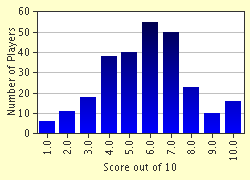Quiz Answer Key and Fun Facts
1. May 10th 1940 saw the emergence of 'Blitzkrieg' in the European war scene for the first time with devastating effects. A crack troop of German paratroopers landed at the gates of the heavily fortified Belgian fortress of Eben Emael. Using explosives and very quick manoevures, the concrete walls were blown to pieces and confusion reigned among the Belgian defenders. Within the space of 10 hours the Germans truimphed, and the use of panzers and superior air power helped the paratroopers take control and finally take Maastricht. The architect of this strike was General Erich von Manstein, but it was not his idea to use 'Blitzkrieg': this was the brainchild of a Panzer General who persuaded Adolf Hitler to use this form of warfare. Who was it?
2. When the Germans invaded France and the Low Countries it was said that the Allies had far fewer tanks than those of the ten Panzer divisions in action. However, this was not the case, in fact the German's mustered 2,349 tanks, whilst the French and the British Expeditionary Force (BEF) had a combined total of 3,310 tanks. What significant difference between the two rival forces helped the Germans overcome their numerical disadvantage?
3. Which Dutch city was heavily bombed while the Dutch were negotiating a ceasefire with the Germans?
4. Major General Harold Franklyn was given orders to defend and secure the small town of Arras in the north-west France. After seeing that his French counterparts were nowhere near prepared for a Panzer onslaught, he moved his battalion of the Durham Light Infantry and First Army Tank brigade off to face the advancing German Panzers. Much to his despair his men came under repeated attacks from the Lufftwaffe's notorious Stukas. Many of the BEF tanks were either destroyed or damaged and Franklyn, persued by the Germans, limped back to Arras. But what turn of events gave the Allies their one and only tank victory of the campaign?
5. The Allies reached Dunkirk and became quickly surrounded by the aggressive German raiders. Plans had been laid previously for a mass evacuation and Field Marshall Gort was preparing to withdraw along the longest and best beaches at the closest point to the English mainland. However, this plan was not practical in the circumstances, and Dunkirk became the only choice. But which French coastal town would have been the better option for evacuation?
6. What was the codename given to the evacuation mission?
7. On May 26th 1940 advice was sent Field Marshall Gort to fall back to the coast despite it already being done. Who was the Secretary of State for War responsible for this advice?
8. Churchill made a famous speech to the British nation after the BEF had been rescued from the Dunkirk beaches. But what part of the quote is missing? "We shall defend our island whatever the cost may be. We shall fight on the beaches, ---------------------, we shall fight in the fields and in the streets, we shall fight in the hills. We shall never surrender."
9. Who on June 5th 1940 was heard saying?
"Dunkirk has fallen ... With it has ended the greatest battle of world history. Soldiers! My confidence in you knew no bounds. You have not disappointed me."
10. The scale of the evacutation remained for many years one of modern histories amazing acts of war. The number of personnel and transportation used was on a scale that was not to be witnessed again for some years. However, what day and event saw the same numbers of personnel and transport used in an even more dramatic act of war four years later?
Source: Author
doomed
This quiz was reviewed by FunTrivia editor
bloomsby before going online.
Any errors found in FunTrivia content are routinely corrected through our feedback system.

